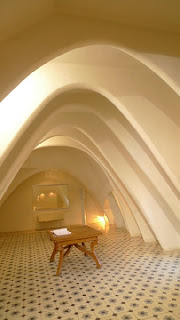Community. Gather. Organic.
Sunday, 27 February 2011
A Great Piece of Architecture - Casa Batllo (Antoni Gaudi)
Situated on the bustling Passeig de Gracia of Barcelona, Antoni Gaudi’s Casa Battlo is an outstanding example of the way in which buildings may hold both functional and artistic value. A remodelling of an 1870s industrial building, Gaudi’s significant renovations were executed between 1904 and 1906. As is the case with the majority of Gaudi’s projects, the Casa Batllo (fondly named by locals as Casa dels Ossos – House of Bones) is directly inspired by the natural world – an enduring source of significant interest for Gaudi. From the skeletal form of the spiralling banister of its staircase to the building’s ventilation system of catenary arches, suggestive of a snake’s ribcage, almost every detail of the building references the natural world. Coupled with Gaudi’s sensitivity to the ergonomic requirements of his client, exemplified in the attention to detail he paid to all aspects of the building - from the slight curvature of the banister to the perfectly formed shape of the doorhandles - it was Gaudi’s synthesis of art and utility that highlights the multifunctional value that architecture holds.
A Photograph of Something Beautiful
Taken at the site of the atomic bombing of Hiroshima, Japan (2009) this photograph captures just a fragment of the thousands of strings of paper cranes that decorate the site’s memorial. The beauty of this photograph extends beyond the sea of geometric and architectural shapes of its individual origami pieces, and the overwhelming kaleidoscope of colour that they produce. Indeed, for me, this photograph is most beautiful for what it represents – the triumph of a desire for peace in the face of conflict. It exemplifies the core value of collaboration as the cranes, drawn from all corners of the world are strung alongside one-another, irrespective of their distinctive colours and places from which they originate.
Creative Work: 'Memento Mori' - Jacqueline Lindeman
This collection of graphite drawings comprised a significant portion of my HSC visual arts body of work. The material process of these drawings were considerably influenced by the renowned Australian artist, William Delafield Cook, whose work reflects a deep felt association with the European artistic traditions of meticulous realism – the style for which he is best known. Collectively, they explore humans’ perception of their own mortality, alluding to the variety of religious, cultural, social and spiritual responses to the inevitability of our mortality.
Technically, it is the exaggerated use of tone, and the employment of significant contrast between shadow, highlight and lowlight that not only enhances the perspective of the drawings but increases their emotional intensity. Indeed, coupled with a sense of selectivity in terms of the tightly cropped nature of the individual drawings, the drawings are emblematic of our ability to produce emotive images that encourage a subjective response from an audience, through the implementation of subtle technical decisions.
Subscribe to:
Comments (Atom)







